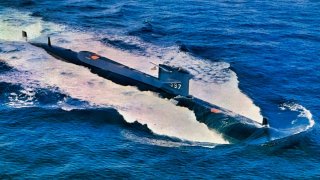USS Tullibee Was One-Of-A-Kind U.S. Navy Hunter-Killer Submarine
The USS Tullibee served throughout the Cold War, primarily in Atlantic and Mediterranean deployments. She worked extensively with NATO and allied ships to improve sonar capabilities and earned several awards for her work.
The 1950s and 1960s marked a period of intense development of submarines. Spurred on by Cold War rivalry and a massive influx of new technologies, the U.S. Navy began producing a new variant every few years. One such sub was the USS Tullibee, the first and only ship in her class, making her a unique boat.
Introducing the USS Tullibee
Designed as a hunter-killer (HK) submarine, the Tullibee’s primary mission was to detect and destroy enemy submarines. At the time, Navy doctrine still held the HK and attack missions separate, with the former dedicated to conducting anti-submarine (ASW) operations and the latter focused on shipping and surface combatants.
The advent of nuclear-powered submarines had turned ASW on its head, and the Navy was left scrambling to develop new tactics and methodology to counter this threat. In 1956, Admiral Arleigh Burke, the Chief of Naval Operations, ordered a study from the National Academy of Sciences to determine the best way to approach nuclear-powered ASW.
Child of Nobska
The resulting study was Project Nobska, so-called for Nobska Point near the Woods Hole Institute in Massachusetts. Representatives from the Atomic Energy Commission, submarine designers, and Nobel laureates took part in the design process. It yielded several notable recommendations, among them the discussion that would eventually yield the Polaris missile system, the cornerstone of the Navy’s nuclear deterrence.
When it came to submarine ASW, the Nobska Report is often cited for having a direct impact on the redesign of subs. Though the design was technically directed by the Naval Underwater Systems Center (NUWC), it was released in the same month as the Nobska Report. The Tullibee was the first sub to go to sea with these changes and proved their worth.
Tullibee’s Unique Design
Starting with the Type XXI U-boats of the German Navy, naval architects realized the potential that streamlined hulls represented for greater underwater speeds. The advent of nuclear power, with its theoretically unlimited underwater cruising range, placed an even greater premium on underwater speed. The USS Albacore, a research sub launched in the early 1950s, was the first sub to boast the teardrop shape and quickly proved the concept. The Tullibee followed suit, however, her nuclear reactor promised even greater performance.
The teardrop hull also allowed the Tullibee to incorporate a major change in her sonar configuration. The Barracuda class boats of the ‘50s had demonstrated the efficiency of a bow-mounted sonar, and now designers wished to improve upon that. The teardrop hull allowed for the installation of a spherical sonar in the bow, albeit at the expense of her torpedo tubes.
Previous boats had mounted their torpedo tubes in the bow, however, the inclusion of the large sonar meant they had to be moved amidships and angled outward. This configuration proved so successful it has been incorporated in every U.S. sub since. The final major modification was to the Tullibee’s propulsion. While other nuclear-powered subs used a conventional turbine driven by superheated steam from the reactor, the Tullibee used a turbo-electric drive.
In the words of her first Skipper: “The rotating machinery generators and main motors are individually sound isolated and decoupled and can be run at various speeds, rather than a great mass rotating at the harmonics of the basic speed of the main shaft. The main motor can be supplied from the battery much more effectively than the emergency propulsion motor found on geared turbine ships.”
The primary benefits of this propulsion system were how quiet and how responsive it was. By that time, noise was already known to be a major concern for subs and anything that could be done to make the boats quieter was a benefit. Having only a single propeller, or screw, made the Tullibee less maneuverable at slow speeds and so being able to swiftly switch between forward and reverse made her far more manageable in evolutions such as docking.
These modifications all proved highly successful and the Tullibee put to sea on her shakedown cruise in January 1961.
The Legacy of the USS Tullibee
The USS Tullibee served throughout the Cold War, primarily in Atlantic and Mediterranean deployments. She worked extensively with NATO and allied ships to improve sonar capabilities and earned several awards for her work.
Ultimately, however, her design proved too costly for naval planners. While she had some advantages over her contemporary Thresher class, in most areas she was deliberately made inferior as her focus was supposed to be strictly HK. Having a cheaper, more effective sub in the Thresher class virtually doomed the Tullibee as a design class from the start.
Although she was the only boat in her class, the USS Tullibee did include important milestones that forever changed submarine design.
About the Author
Maya Carlin is an analyst with the Center for Security Policy and a former Anna Sobol Levy Fellow at IDC Herzliya in Israel. She has by-lines in many publications, including The National Interest, Jerusalem Post, and Times of Israel. You can follow her on Twitter: @MayaCarlin.


